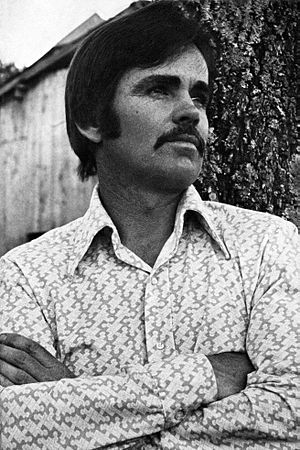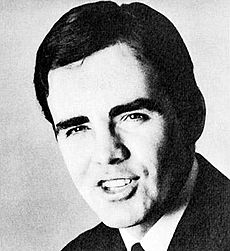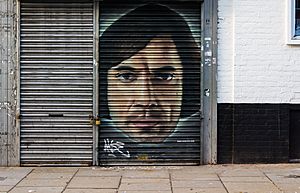Cormac McCarthy facts for kids
Quick facts for kids
Cormac McCarthy
|
|
|---|---|

McCarthy in 1973
|
|
| Born | Charles Joseph McCarthy Jr. July 20, 1933 Providence, Rhode Island, U.S. |
| Died | June 13, 2023 (aged 89) Santa Fe, New Mexico, U.S. |
| Occupation |
|
| Alma mater | University of Tennessee (no degree) |
| Genre | Southern gothic, Western, post-apocalyptic |
| Notable works |
|
| Spouses |
Lee Holleman
(m. 1961; div. 1962)Anne DeLisle
(m. 1966; div. 1981)Jennifer Winkley
(m. 1997; div. 2006) |
| Children | 2 |
| Signature | |
 |
|
Cormac McCarthy (born Charles Joseph McCarthy Jr., July 20, 1933 – June 13, 2023) was an American writer. He wrote many books, plays, and screenplays. His stories often took place in the American West or in a future world after a big disaster. He was known for his unique writing style, which used very little punctuation. Many people think he was one of the greatest American writers of his time.
McCarthy was born in Providence, Rhode Island. He grew up mostly in Tennessee. He went to the University of Tennessee for a while but left to join the U.S. Air Force. His first book, The Orchard Keeper, came out in 1965. He won awards that helped him travel and write more books. One of his most famous books, Blood Meridian (1985), was first met with mixed reviews. But now, many people see it as his best work.
He became very popular with All the Pretty Horses (1992). This book won him two major awards. It was the first book in his Border Trilogy. His novel No Country for Old Men (2005) was made into a very successful movie. In 2006, he wrote The Road, which won the Pulitzer Prize for Fiction. Many of his books have been made into movies. McCarthy also worked with scientists at the Santa Fe Institute. He wrote an essay about the human unconscious and how language began. His last two novels, The Passenger and Stella Maris, were published in 2022.
Contents
Life Story
Growing Up
Cormac McCarthy was born on July 20, 1933. He was one of six children. His family moved to Knoxville, Tennessee, in 1937. His father was a lawyer. McCarthy once said his family was considered rich because their neighbors lived in small shacks. One of his childhood friends, Jim Long, later appeared as a character in his book Suttree.
McCarthy went to St. Mary's Parochial School. He also attended Knoxville Catholic High School. He was an altar boy at a church in Knoxville. As a child, he loved to explore his own interests more than school. He once said he had "every hobby there was."
In 1951, he started college at the University of Tennessee. He studied physics and engineering. He became interested in writing when a professor asked him to fix the punctuation in some old essays. McCarthy left college in 1953 to join the U.S. Air Force. While in Alaska, he read many books for the first time. He went back to college in 1957. He published two stories in the student magazine. He won awards for his creative writing. In 1959, he left college for good and moved to Chicago.
McCarthy changed his first name from Charles to Cormac for his writing career. This was to avoid being confused with a famous ventriloquist's dummy named Charlie McCarthy. Cormac was a family nickname for his father. Some say he changed it to honor an old Irish leader.
Early Books
Random House published McCarthy's first book, The Orchard Keeper, in 1965. He wrote it while working part-time in Chicago. Critics liked his writing style. The book won an award for best first novel.
In 1965, McCarthy won an award that let him travel to Europe. On a ship, he met Anne DeLisle. They got married in England in 1966. He received another grant, which he used to travel and write his second book, Outer Dark (1968).
In 1969, McCarthy and his wife moved to Louisville, Tennessee. They bought an old barn, and McCarthy fixed it up himself. They lived very simply. He wrote his next book, Child of God (1973), there. In 1976, he moved to El Paso, Texas.
In 1974, a director from PBS asked McCarthy to write a TV show script. McCarthy spent a year traveling to research the story. The show, The Gardener's Son, aired in 1977. It was nominated for two Emmy awards.
In 1979, McCarthy published Suttree. He had worked on this book for 20 years. It was based on his experiences in Knoxville.
In 1981, McCarthy received a special award called a MacArthur Fellowship. This award gave him money to travel to the South-West. There, he researched his next book, Blood Meridian, or the Evening Redness in the West (1985). This book is known for its intense stories. At first, many critics didn't fully appreciate it. But over time, it became very famous. Some even called it one of the greatest American novels. McCarthy was living in a small, simple cottage in El Paso at this time.
Before 1991, most of McCarthy's books didn't sell many copies. He was known as a great writer, but not many people knew about him.
Becoming Famous
In 1992, McCarthy finally became widely known. This happened after he published All the Pretty Horses. The book won important awards and became a bestseller. It sold many copies quickly. This book was the first part of his Border Trilogy. The other books in the series were The Crossing (1994) and Cities of the Plain (1998).
McCarthy first thought of his book No Country for Old Men (2005) as a movie script. Because of this, the book has a lot of talking and not much description. The Coen brothers made it into a movie in 2007. The film won four Academy Awards, including Best Picture.
In the early 2000s, McCarthy got an idea for a story while staying in a motel. He imagined what a city might look like in 100 years, after a disaster. This idea grew into his book The Road. It came out in 2006 and won the Pulitzer Prize for Fiction. The book was made into a movie in 2009. It starred Viggo Mortensen.

In 2007, famous TV host Oprah Winfrey chose The Road for her book club. McCarthy agreed to his first TV interview for her show. He told Oprah that he didn't know many writers. He said he liked spending time with scientists more. He also shared stories about how poor he sometimes was as a writer. He explained that his young son inspired The Road.
In 2012, McCarthy sold a movie script he wrote called The Counselor. It was made into a film in 2013.
Work with Scientists
McCarthy was a leader at the Santa Fe Institute (SFI). This is a place where scientists from different fields study complex systems. McCarthy didn't have a science background. But he fit in well because he thought differently. In 2017, he published his first non-fiction essay. It was called "The Kekulé Problem". In it, he wrote about the unconscious mind and how language might have started. He believed that language is something humans created, not something we are born with.
His last two books, The Passenger and Stella Maris, came out in 2022. These books were influenced by his time with scientists.
How He Wrote
His Style
He left the beer on the counter and went out and got the two packs of cigarettes and the binoculars and the pistol and slung the .270 over his shoulder and shut the truck door and came back in.
McCarthy used very little punctuation in his writing. He often used the word "and" instead of commas. He told Oprah Winfrey that he liked "simple sentences." He used capital letters, periods, and sometimes commas or colons. But he never used semicolons. He also didn't use quotation marks for dialogue. He thought they made the page look messy. Even without quotation marks, readers could usually tell who was speaking. He learned this style early on when he helped a professor edit a book.
People praised his powerful use of language. Some said his writing was like early Hemingway. After 1993, his books used simpler words.
Story Ideas
There's no such thing as life without bloodshed. The notion that the species can be improved in some way, that everyone could live in harmony, is a really dangerous idea. Those who are afflicted with this notion are the first ones to give up their souls, their freedom. Your desire that it be that way will enslave you and make your life vacuous.
McCarthy's books often show characters facing tough challenges. Many of his stories show people struggling against society. They often act on instinct rather than feelings. Another common idea in his books is that people in charge, like police, might not always be good or helpful.
Using Spanish
McCarthy spoke Spanish well. He lived in Spain and later in places like El Paso, Texas, and Santa Fe, New Mexico. Because of this, his books often mix Spanish and English. He used Spanish dialogue without translating it. This made his stories feel more real. Many of his characters also spoke Spanish, even if they had English-sounding names.
How He Worked
McCarthy focused only on writing. He chose not to work other jobs. He said, "You have to be dedicated, but it was my number-one priority." Early in his career, this meant he was sometimes very poor.
He had a strong work ethic. He liked to work on several projects at once. He would spend hours each day on different books. He did a lot of research for his stories. He wanted to make sure the historical settings were accurate. He also edited his own writing very carefully. Sometimes he would work on a book for many years before it was published. He didn't plan out his stories in detail. He thought writing was a "subconscious process" that needed room for new ideas.
After 1958, McCarthy wrote all his books and letters on a mechanical typewriter. He bought an Olivetti Lettera 32 for $50 in the 1960s. He typed about five million words on it over 50 years! He kept it working by just blowing dust out of it. In 2009, his old typewriter was sold at an auction for a lot of money. The money went to the Santa Fe Institute. He then bought an identical typewriter for only $11.
Personal Life
In the late 1990s, McCarthy moved to Tesuque, New Mexico, near Santa Fe. He lived there with his son, John.
Sometimes, fake social media accounts pretending to be McCarthy appeared online. In 2013, a fake Twitter account gained many followers. His publisher confirmed it was fake, saying McCarthy didn't even own a computer. In 2016, a false rumor spread that McCarthy had died. A newspaper joked, "Cormac McCarthy isn't dead. He's too tough to die."
His Views
McCarthy didn't talk much about his political opinions. He once said he respected writers who wrote about "life and death." He didn't like writers who he felt didn't deal with serious topics. He said his favorite book was Moby-Dick. He also thought The Brothers Karamazov, Ulysses, and The Sound and the Fury were "great" books.
He preferred spending time with scientists over other writers. He admired how much science had advanced. He even said that writing was "way, way down at the bottom" of his interests.
Death
Cormac McCarthy passed away from natural causes at his home in Santa Fe on June 13, 2023. He was 89 years old.
His Impact
In 2003, a famous literary critic named Harold Bloom called McCarthy one of the four most important living American novelists. He believed that McCarthy's books, especially Blood Meridian, would be remembered for a long time. Bloom called Blood Meridian "the greatest single book since Faulkner's As I Lay Dying."
All of McCarthy's personal papers are kept at the Wittliff Collections at Texas State University. This collection includes his writings and letters. It helps people study his work.
A professor named J.T. Barbarese said that McCarthy was "our greatest stylist." He noted that McCarthy often explored ideas about where evil comes from and how history shapes us.
Images for kids
See also
 In Spanish: Cormac McCarthy para niños
In Spanish: Cormac McCarthy para niños






